The 10 Smallest Snakes In Florida
#mobileSnakeQuizControls { overflow: hidden; text-overflow: ellipsis; white-space: nowrap; }
@media (min-width: 481px) {
.mobile-top-content {
display: none;
}
}
#mobileTopContentCTACarouselControls { overflow: hidden; text-overflow: ellipsis; white-space: nowrap; }
.mobile-top-content .more { color: #fff; }
.mobile-top-content a { color: #fff; text-decoration: underline; }
.mobile-top-content a:hover { color: #fff; text-decoration: underline; }
@media (max-width: 480px) {
.mobile-top-content {
background-color: #06a10b;
color: #fff;
text-align: center;
/*height: 60px;
padding-top:5px;*/
font-size:80%;
/* display: block; */
margin: 0px -30px;
}
}
Spanning a vast 65,000 square miles, it’s not surprising that Florida is absolutely teeming with life. With some of the most diverse ecosystems, there are plenty of habitats for various animals – both large and small. Animals that can come into both categories are snakes. The largest snakes in Florida can reach a massive 19 feet long, but what about the smallest? Join us as we discover the smallest snakes in Florida!
#10. Florida Brown Snake
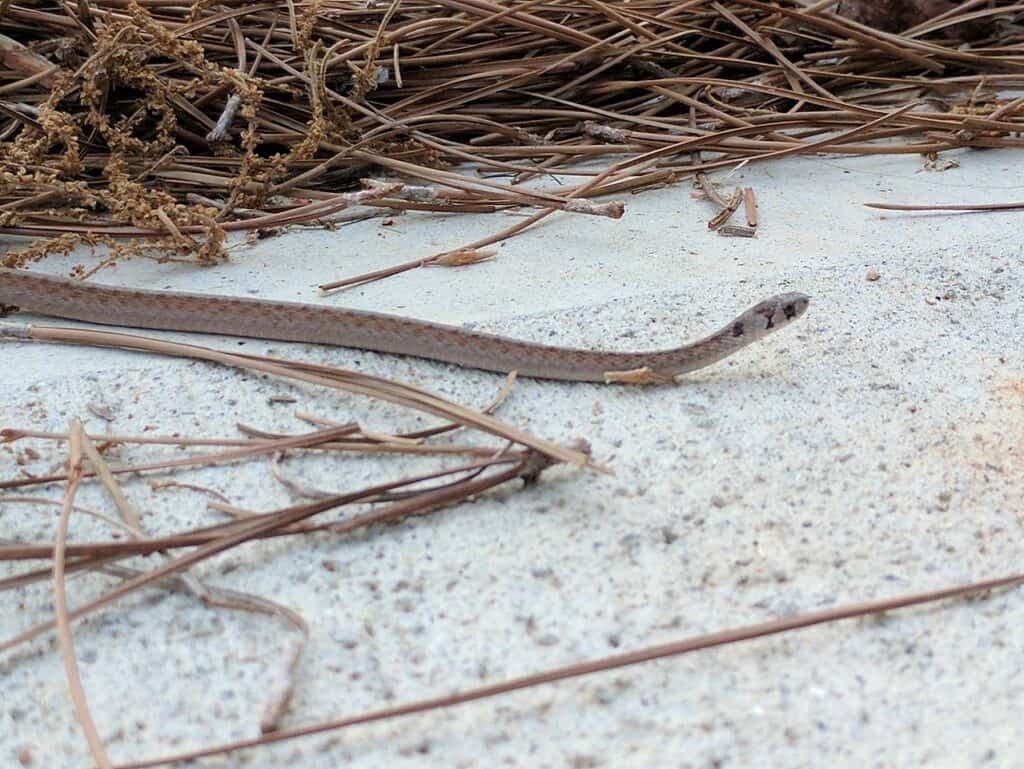
Sreejithk2000 / Creative Commons – License
Florida brown snakes are endemic to Florida and Georgia, and they only reach 9 to 13 inches long. They are mostly brown but have a light stripe running down their back, with black spots on either side. Florida brown snakes are most active at night and live in various habitats – including wetlands. However, they prefer to shelter underneath logs, leaves, and rocks. They are non-venomous snakes and eat earthworms, slugs, and insects, which are all grabbed and swallowed alive.
button.pulse {
transform: scale(1); animation: pulse 2s infinite;
box-shadow: 0 0 0 0 rgba(11, 247, 25, 1);
}
@keyframes pulse {
0% { transform: scale(0.90); box-shadow: 0 0 0 0 rgba(11, 247, 25, 0.5); }
60% { transform: scale(1); box-shadow: 0 0 0 15px rgba(11, 247, 25, 0); }
100% { transform: scale(0.90); box-shadow: 0 0 0 0 rgba(11, 247, 25, 0); }
}
#9. Dekay’s Brown Snake

Jay Ondreicka/Shutterstock.com
Another small snake is the Dekay’s brown snake which is often confused for the Florida brownsnake. Dekay’s brown snakes have an incredibly similar appearance. They are 9 to 13 inches long and are predominantly brown. They also have the same light stripe and black spots on the back. These snakes are adaptable and live in a wide variety of habitats. They are not venomous, and their main diet is earthworms, slugs, and insects. Predators of Dekay’s brown snakes are toads, birds, and other snakes.
#8. Ring-Necked Snake
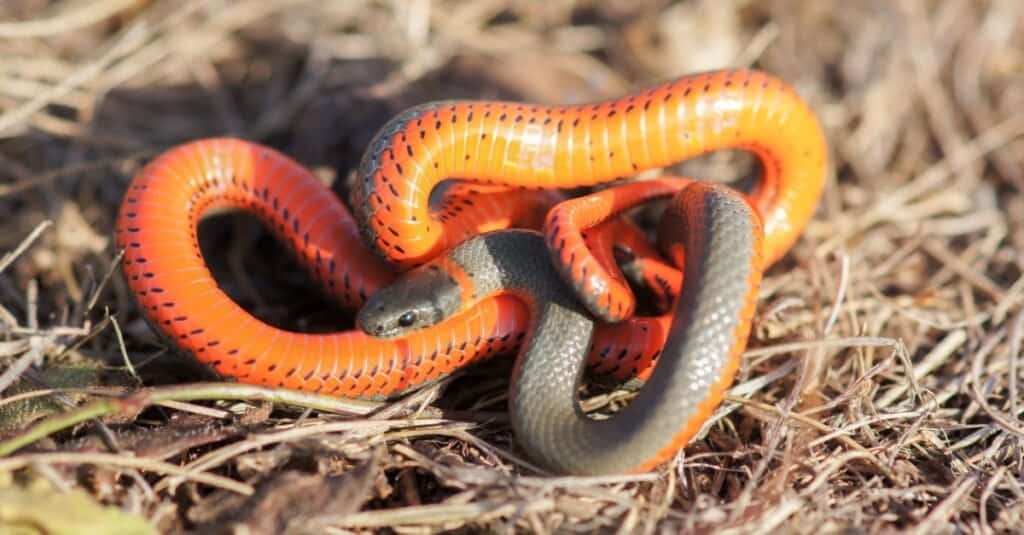
yhelfman/Shutterstock.com
One of the most vibrant snakes on the list is the ring-necked snake which is named for the bright ring of color around its neck. Ring-necked snakes are 8 to 14 inches long and are black on their dorsal side but vibrant red, orange, or yellow on their bellies. Their habitat is varied, but they prefer areas with plenty of vegetation for them to hide underneath. Ring-necked snakes mainly eat lizards, salamanders, earthworms, and slugs. They are not truly venomous and are not dangerous to humans. However, they immobilize their prey using a mild venom-like substance which is produced in the Duvernoy gland and injected using two elongated rear fangs.
#7. Red-Bellied Snake
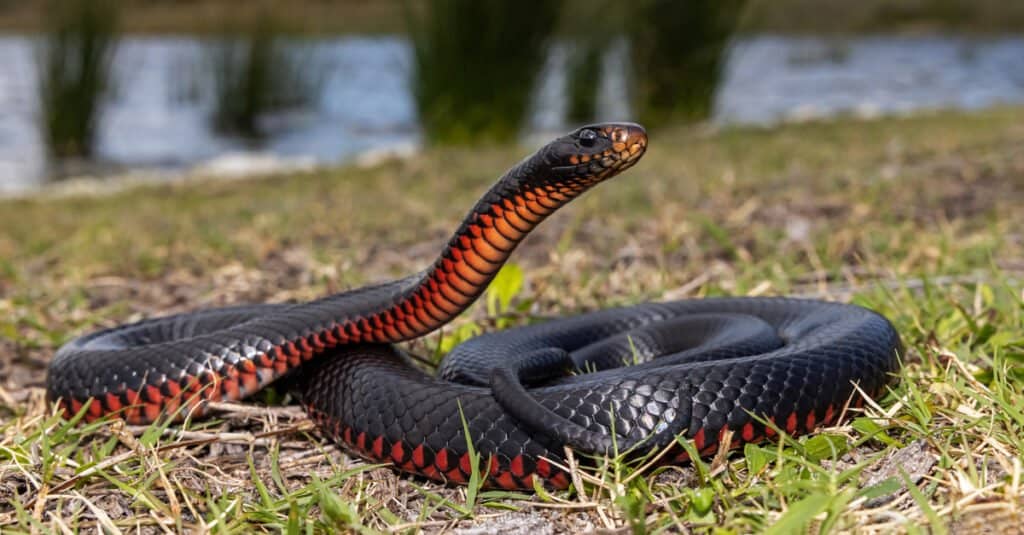
Ken Griffiths/Shutterstock.com
Another small, non-venomous snake is the red-bellied snake which only reaches 8 to 10 inches long. Red-bellied snakes are thin-bodied and reddish-brown, with faint stripes down their back and a bright red belly. There are three recognized subspecies, one of which is the Florida red-bellied snake. Although they live in a range of habitats as a species, the Florida subspecies prefer ponds and swamps. Females give birth to between 2 and 6 live young in the summer, which are only 2 to 4 inches long. Red-bellied snakes are primarily nocturnal and mainly eat slugs and earthworms.
#6. Southeastern Crowned Snake

John Sullivan / Creative Commons – License
A small brown snake with a black head is the southeastern crowned snake that grows only to be between 8 and 10 inches long. Southeastern crowned snakes are endemic to the southeastern area of the United States and are typically found in the Panhandle region of Florida. They usually live in woodlands, where they are found underneath logs and rocks. Southeastern crowned snakes prefer areas with loose and sandy soil that they can burrow into – which is how they react when threatened. Like ring-necked snakes, these snakes are not dangerous to humans but are mildly venomous to their prey. Southeastern crowned snakes eat worms, spiders, centipedes, and termites. They are preyed on by kingsnakes and the venomous coral snake.
#5. Smooth Earth Snake

Matt Jeppson/Shutterstock.com
Native to the eastern U.S., smooth earth snakes are only 7 to 10 inches long. They have slender bodies and are usually a glossy brown color with white bellies. Smooth earth snakes have small heads and a noticeably pointed snout. They usually live in forests that are in damp regions – often near marshes – and prefer to burrow into loose soil or under leaves. Females give birth to live young during the summer months, and the juveniles are usually around 2.5 inches long. Smooth earth snakes are not venomous and are not dangerous to humans. They mainly eat earthworms, although slugs and snails also make up part of their diet.
#4. Rough Earth Snake
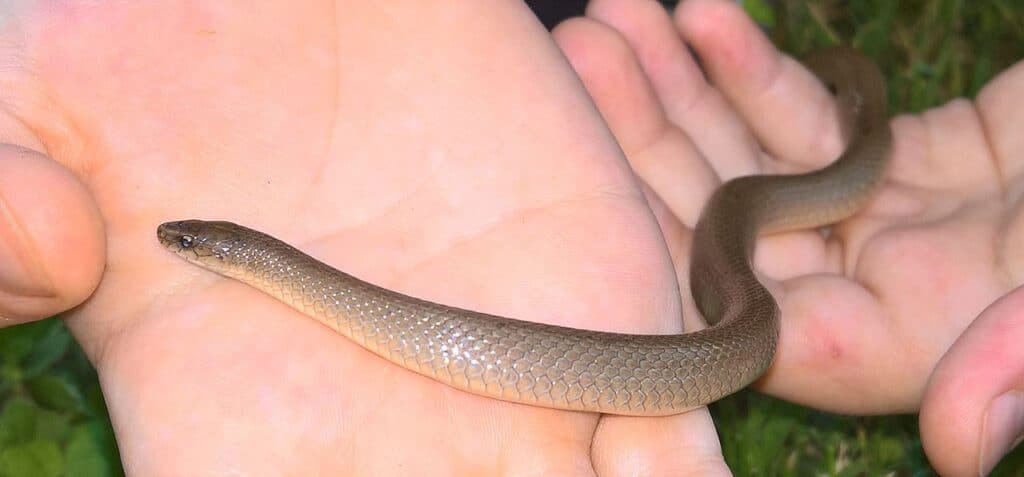
Kyle Wiering / Creative Commons – License
Although they are often confused with smooth earth snakes at first glance, rough earth snakes have a snout that is less pointed and scales that are not as smooth. Rough earth snakes are 7 to 10 inches long and are typically brown with white or yellowish bellies. These snakes live in both forests and urban areas where there is plenty of cover for them – such as rocks, leaf litter, or compost. They often burrow into loose soil in search of their prey. Rough earth snakes eat mainly worms but also slugs and snails. Due to their small size, they are often preyed on by birds and larger snakes.
#3. Rim Rock Crowned Snake
An endangered snake on the list is the rim rock crowned snake. Rim rock crowned snakes are endemic to Florida and are only found in the southern regions of the state. They are tiny snakes that are only 7 to 9 inches long and have black heads. They have tan to dark brown bodies with white bellies. These snakes live in pine flatwoods and hardwood hammocks. They also live in an area known as the Miami rim rock formation, which is where they get their name from. They are completely harmless to humans, and their diet consists only of small prey – such as spiders, insects, and some scorpions.
#2. Florida Crowned Snake
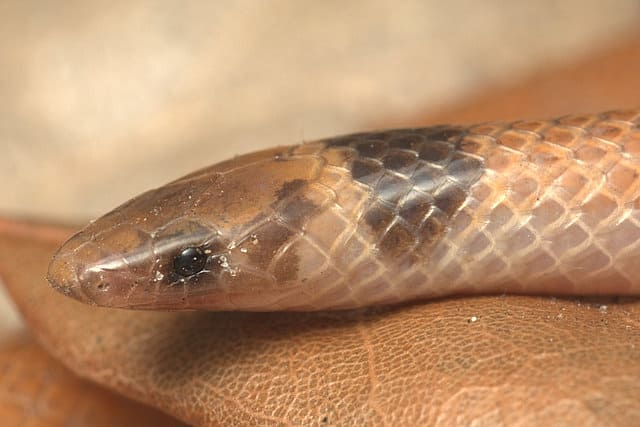
Alessandro Catenazzi / Creative Commons – License
Again reaching only 7 to 9 inches long, Florida crowned snakes are also endemic to Florida, although they are not found in the Florida Keys or the Panhandle region. Florida crowned snakes have a similar appearance to rim rock crowned snakes, with tan bodies, white bellies, and black heads. However, they prefer sandy habitats such as sand dunes and dry pine flatwoods. Florida crowned snakes like to burrow into loose soil and occupy burrows that other animals have made. They eat worms, snails, and spiders. Although they are harmless to humans, they produce mild venom, which they use to subdue their prey.
#1. Brahminy Blindsnake

Radiant Reptilia/Shutterstock.com
The smallest snake in Florida is the brahminy blind snake. Brahminy blind snakes are not a native species to Florida. Instead, they are native to Africa and Asia. However, they were first introduced to Florida in the 1970s. Brahminy blind snakes are tiny and only reach lengths between 4.5 and 6.5 inches long. They are thin and dark gray or purple, which often leads to them being mistaken for earthworms. Their head and tail are both blunt, and it can be difficult to distinguish the two. Brahminy blind snakes live in both agricultural and urban areas, where they are found underneath leaves and logs. However, they are excellent at burrowing and also live underground and in ant and termite nests, where they eat the larvae and eggs from them. Due to their small size, they have many predators.
Discover the “Monster” Snake 5X Bigger than an Anaconda
Every day A-Z Animals sends out some of the most incredible facts in the world from our free newsletter. Want to discover the 10 most beautiful snakes in the world, a “snake island” where you’re never more than 3 feet from danger, or a “monster” snake 5X larger than an anaconda? Then sign up right now and you’ll start receiving our daily newsletter absolutely free.
More from A-Z Animals
.more-snake-card-image { max-height:140px !important; }
#mobileSnakeQuizControls { overflow: hidden; text-overflow: ellipsis; white-space: nowrap; }
@media (min-width: 481px) {
.mobile-top-content {
display: none;
}
}
#mobileTopContentCTACarouselControls { overflow: hidden; text-overflow: ellipsis; white-space: nowrap; }
.mobile-top-content .more { color: #fff; }
.mobile-top-content a { color: #fff; text-decoration: underline; }
.mobile-top-content a:hover { color: #fff; text-decoration: underline; }
@media (max-width: 480px) {
.mobile-top-content {
background-color: #06a10b;
color: #fff;
text-align: center;
/*height: 60px;
padding-top:5px;*/
font-size:80%;
/* display: block; */
margin: 0px -30px;
}
}
Spanning a vast 65,000 square miles, it’s not surprising that Florida is absolutely teeming with life. With some of the most diverse ecosystems, there are plenty of habitats for various animals – both large and small. Animals that can come into both categories are snakes. The largest snakes in Florida can reach a massive 19 feet long, but what about the smallest? Join us as we discover the smallest snakes in Florida!
#10. Florida Brown Snake

Sreejithk2000 / Creative Commons – License
Florida brown snakes are endemic to Florida and Georgia, and they only reach 9 to 13 inches long. They are mostly brown but have a light stripe running down their back, with black spots on either side. Florida brown snakes are most active at night and live in various habitats – including wetlands. However, they prefer to shelter underneath logs, leaves, and rocks. They are non-venomous snakes and eat earthworms, slugs, and insects, which are all grabbed and swallowed alive.
button.pulse {
transform: scale(1); animation: pulse 2s infinite;
box-shadow: 0 0 0 0 rgba(11, 247, 25, 1);
}
@keyframes pulse {
0% { transform: scale(0.90); box-shadow: 0 0 0 0 rgba(11, 247, 25, 0.5); }
60% { transform: scale(1); box-shadow: 0 0 0 15px rgba(11, 247, 25, 0); }
100% { transform: scale(0.90); box-shadow: 0 0 0 0 rgba(11, 247, 25, 0); }
}
#9. Dekay’s Brown Snake

Jay Ondreicka/Shutterstock.com
Another small snake is the Dekay’s brown snake which is often confused for the Florida brownsnake. Dekay’s brown snakes have an incredibly similar appearance. They are 9 to 13 inches long and are predominantly brown. They also have the same light stripe and black spots on the back. These snakes are adaptable and live in a wide variety of habitats. They are not venomous, and their main diet is earthworms, slugs, and insects. Predators of Dekay’s brown snakes are toads, birds, and other snakes.
#8. Ring-Necked Snake

yhelfman/Shutterstock.com
One of the most vibrant snakes on the list is the ring-necked snake which is named for the bright ring of color around its neck. Ring-necked snakes are 8 to 14 inches long and are black on their dorsal side but vibrant red, orange, or yellow on their bellies. Their habitat is varied, but they prefer areas with plenty of vegetation for them to hide underneath. Ring-necked snakes mainly eat lizards, salamanders, earthworms, and slugs. They are not truly venomous and are not dangerous to humans. However, they immobilize their prey using a mild venom-like substance which is produced in the Duvernoy gland and injected using two elongated rear fangs.
#7. Red-Bellied Snake

Ken Griffiths/Shutterstock.com
Another small, non-venomous snake is the red-bellied snake which only reaches 8 to 10 inches long. Red-bellied snakes are thin-bodied and reddish-brown, with faint stripes down their back and a bright red belly. There are three recognized subspecies, one of which is the Florida red-bellied snake. Although they live in a range of habitats as a species, the Florida subspecies prefer ponds and swamps. Females give birth to between 2 and 6 live young in the summer, which are only 2 to 4 inches long. Red-bellied snakes are primarily nocturnal and mainly eat slugs and earthworms.
#6. Southeastern Crowned Snake

John Sullivan / Creative Commons – License
A small brown snake with a black head is the southeastern crowned snake that grows only to be between 8 and 10 inches long. Southeastern crowned snakes are endemic to the southeastern area of the United States and are typically found in the Panhandle region of Florida. They usually live in woodlands, where they are found underneath logs and rocks. Southeastern crowned snakes prefer areas with loose and sandy soil that they can burrow into – which is how they react when threatened. Like ring-necked snakes, these snakes are not dangerous to humans but are mildly venomous to their prey. Southeastern crowned snakes eat worms, spiders, centipedes, and termites. They are preyed on by kingsnakes and the venomous coral snake.
#5. Smooth Earth Snake

Matt Jeppson/Shutterstock.com
Native to the eastern U.S., smooth earth snakes are only 7 to 10 inches long. They have slender bodies and are usually a glossy brown color with white bellies. Smooth earth snakes have small heads and a noticeably pointed snout. They usually live in forests that are in damp regions – often near marshes – and prefer to burrow into loose soil or under leaves. Females give birth to live young during the summer months, and the juveniles are usually around 2.5 inches long. Smooth earth snakes are not venomous and are not dangerous to humans. They mainly eat earthworms, although slugs and snails also make up part of their diet.
#4. Rough Earth Snake

Kyle Wiering / Creative Commons – License
Although they are often confused with smooth earth snakes at first glance, rough earth snakes have a snout that is less pointed and scales that are not as smooth. Rough earth snakes are 7 to 10 inches long and are typically brown with white or yellowish bellies. These snakes live in both forests and urban areas where there is plenty of cover for them – such as rocks, leaf litter, or compost. They often burrow into loose soil in search of their prey. Rough earth snakes eat mainly worms but also slugs and snails. Due to their small size, they are often preyed on by birds and larger snakes.
#3. Rim Rock Crowned Snake
An endangered snake on the list is the rim rock crowned snake. Rim rock crowned snakes are endemic to Florida and are only found in the southern regions of the state. They are tiny snakes that are only 7 to 9 inches long and have black heads. They have tan to dark brown bodies with white bellies. These snakes live in pine flatwoods and hardwood hammocks. They also live in an area known as the Miami rim rock formation, which is where they get their name from. They are completely harmless to humans, and their diet consists only of small prey – such as spiders, insects, and some scorpions.
#2. Florida Crowned Snake

Alessandro Catenazzi / Creative Commons – License
Again reaching only 7 to 9 inches long, Florida crowned snakes are also endemic to Florida, although they are not found in the Florida Keys or the Panhandle region. Florida crowned snakes have a similar appearance to rim rock crowned snakes, with tan bodies, white bellies, and black heads. However, they prefer sandy habitats such as sand dunes and dry pine flatwoods. Florida crowned snakes like to burrow into loose soil and occupy burrows that other animals have made. They eat worms, snails, and spiders. Although they are harmless to humans, they produce mild venom, which they use to subdue their prey.
#1. Brahminy Blindsnake

Radiant Reptilia/Shutterstock.com
The smallest snake in Florida is the brahminy blind snake. Brahminy blind snakes are not a native species to Florida. Instead, they are native to Africa and Asia. However, they were first introduced to Florida in the 1970s. Brahminy blind snakes are tiny and only reach lengths between 4.5 and 6.5 inches long. They are thin and dark gray or purple, which often leads to them being mistaken for earthworms. Their head and tail are both blunt, and it can be difficult to distinguish the two. Brahminy blind snakes live in both agricultural and urban areas, where they are found underneath leaves and logs. However, they are excellent at burrowing and also live underground and in ant and termite nests, where they eat the larvae and eggs from them. Due to their small size, they have many predators.
Discover the “Monster” Snake 5X Bigger than an Anaconda
Every day A-Z Animals sends out some of the most incredible facts in the world from our free newsletter. Want to discover the 10 most beautiful snakes in the world, a “snake island” where you’re never more than 3 feet from danger, or a “monster” snake 5X larger than an anaconda? Then sign up right now and you’ll start receiving our daily newsletter absolutely free.







